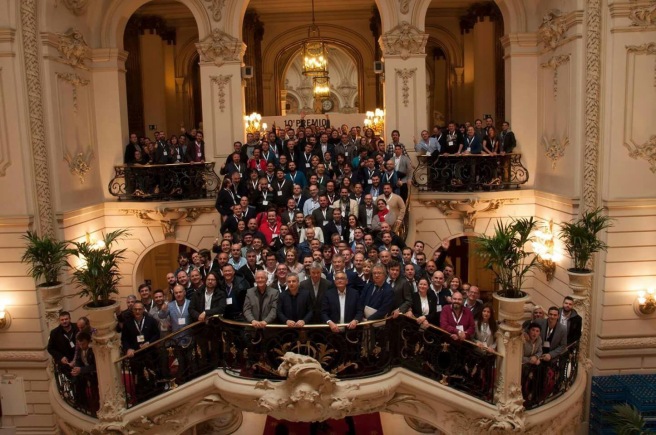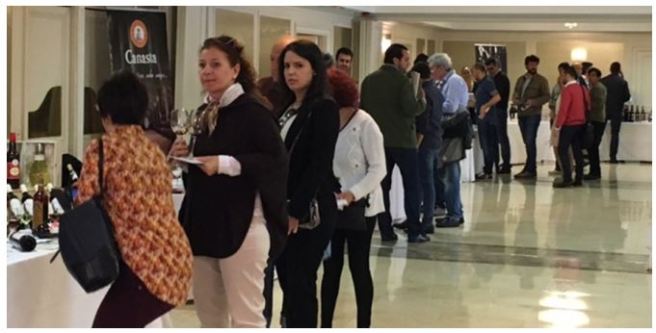
I can’t believe over a month has gone by since the magnificent cata by Primitivo Collantes in Enoteca Barolo. As I said back then he is one of the unsung heroes of the so called sherry revolution and I got the feeling at the time that a lot of people were taken by surprise at just how good the wines – and his presentation of them – were.
One of the most impressive aspects of the night was the emphasis on terroir and viticulture. A first class description of Finca Matalian, its elevation and exposure to the elements (between two “mares” – a joke that is frankly untranslatable and even in Spanish doesn’t work unless you have the accent of the guys in Cadiz) that was followed by explanations of the pruning, the benefits of hand harvesting, the impact on the vine and the effects of a vine under stress, the prohibition on irrigation and importance of the absorbency of the soil. We also had some geology and some talk of abundant diatomeas and then emphasis on the relevance of the location so close (8km) to the sea but high (96m-114m up) – the advantage of the breeze and winds but with the quality albariza. A really top class setting of the scene.
When a winemaker brings two different soil samples you know he cares about terroir. It was fascinating to see these two: from Matalian itself and his other finca, Pozo Galvan. From far away Matalian looked chalky white and Pozo Galvan mottled, but from close to it wasn’t anywhere near as marked. I could try and convince you that they seemed to crumble in different ways but to be honest both were granular: maybe just a slightly finer dust to the Matalian. I did the old TV cop “cocaine” test with the tip of the finger and the diatomeas in the Matalian were immediately apparent. In fact it was clear to me that they were cold water diatomeas* (* these are alternative facts, as far as I could tell they also smelled and tasted the same (and I wouldn’t know a cold water diatomea if I sat on it in the bath)).
Then back to the vine and the yields, and the timing of the harvest in several passes, but thankfully during a lot of this time we were also tasting the wines (which is important, because there is only so much chat you can listen to dry). Specifically, we were supping away at sobretablas from Pozo Galvan and Matalian. A sobretablas is not a mosto – these are fortified and have spent time in a deposit with the occasional little island of flor – but they seem all the more raw for it, and these were spikey and punchy on the nose, with the Matalian slightly more piercing, the Pozo Galvan slightly rounder. On the palate that difference was more evident – the Matalian was that bit sharper and seemed much more direct, straight line, and longer.
After the sobretablas we moved on to two unfortified wines and specifically the Socaire 2014, which in itself is one of those fantastic flavourful palomino wines that stand out, saline but full of herbal, almond, almost-fruit, and then a chance to try a Socaire 2014 Oxidativo, with a touch of further oxidation from an additional 8 months bota ageing. You will have to believe me when I say you could bank those 8 months – I had the two together and the wine is only getting stronger. (Socaire itself means “shelter from the wind” and is a reference to the meteorological conditions on Finca Matalian – again showing how this wine has a clear sense of place.)
After the Socaires, we moved on to two biological wines, the Arroyuelo Fino en Rama and Amontillado Fossi. Now I have had these wines many times but at this tasting they absolutely sang. I had always found the Arroyuelo en Rama exemplary in terms of labelling but I never realized that they were bottled and labelled as the orders came in – with your man to select them. And what a wine it was on the night – a clear inheritor of the beautiful direct line of the sobretablas, but next to the sobretablas (I cunningly kept some from earlier) you could see the progression in verticality, saline edge and vegetable power. A superb example. And the Fossi was at its best too, with direct salinity and honeyed caramel flavour in bags. It is apparently around 18 years old on average already, and Primitivo told us that soon he hoped the average age to bump above 20 years into VOS category. I must say I find that really remarkable for a wine that is as elegant as this one. One of the most underrated wines around.
But however good those wines were there was no doubt about the star of the night: the mother of all moscatels. A frankly beautiful, elegant, light and spritely fifty year old from the “sacristia”. This wine – the grandaddy of the already very good Moscatel Oro Los Cuartillos -was a Fred Astaire of wine, incredibly agile for its content. It had a fantastic menthol quality and lightness and a seriousness of business – like a pianist playing hard with both hands. What a wine it was.
And since then the name of Primitivo Collantes has rung out in Madrid, no doubt. I have never seen the locals so enthused after a tasting – and with good reason. It was top drawer.
 The latest manzanilla from Equipo Navazos (see their ficha here) and once again from the solera of Hijos de Rainera Pérez Marín.
The latest manzanilla from Equipo Navazos (see their ficha here) and once again from the solera of Hijos de Rainera Pérez Marín. 


 A really top class event coming up on April 4 here in Madrid – the second edition of the
A really top class event coming up on April 4 here in Madrid – the second edition of the 



